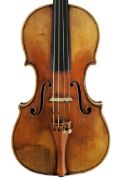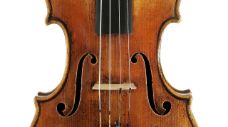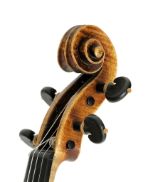Violin, Pierre Silvestre, Lyon, about 1830 to 1840, “ex Moser”
This instrument has a label from Carlo Bergonzi that is not original as well as a handwritten repair label from Antonio Zorzi, Florence, 1887. The violin is built on the Stradivari model and, as a typical representative of 19th century French violinmaking, is now attributed to Pierre Silvestre. The two-piece belly has a regular, medium-wide grain. Its two halves are from the same log. A dendrochronological analysis dated the youngest tree ring to 1763. The one-piece back has broad, horizontal flames. The structure of the rib wood corresponds to that of the back. The pegboard and scroll display tight flames. Silvestre used a large violin model with a fairly flat arching. The very cleanly cut f-holes in the style of Stradivari have fluted lower wings. The style of the purfling brings to mind the Cremonese masters, especially the very typical design of the corners: The purfling miters are deflected deep into the corners in a long, pointed bee sting. The purfle is set far away from the edge, making the broad edge appear massive. The pegbox and scroll are well proportioned, symmetrical and cleanly carved. Tool scarring was intentionally left on the volute. The broad chamfer is likely to have been blackened originally. An intense, red-brown color varnish coating a yellow ground is still clearly evident on the back and the ribs.
This instrument takes its name from violinist Andreas Moser (1859–1925), who was born in Upper Austria and became a student of Joseph Joachim’s at the Royal Conservatory in Berlin in 1878. He was later appointed professor at this institution and became a viola player in Joachim’s string quartet. Moser authored several works on music education and a biography of Joseph Joachim. His instrument, which Joachim also held in very high regard, remained in Moser’s family until the mid-20th century.






